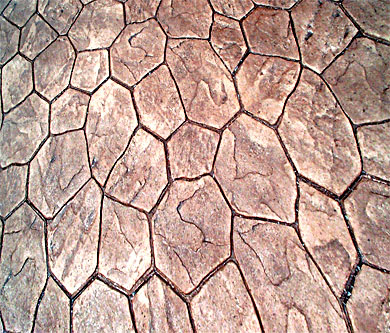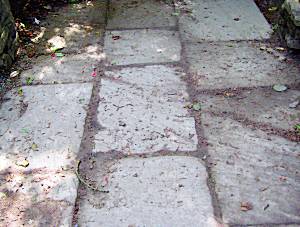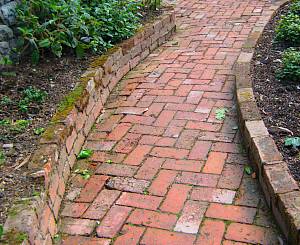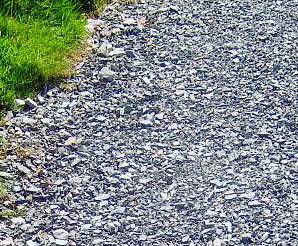Types of Path
The following list is by no means exhaustive, but it covers the most frequently encountered types of path and indicates some of the pros and cons for each of them:
Concrete
This is perhaps the most utilitarian material to use for paths and driveways. You can add some small variation in terms of surface texture and colouring agents can be used to add a little more interest.
Concrete is nonetheless versatile if you want to create a more complicated path. Just like gravel, concrete will go into almost any shape you can conceive and its fluid nature whilst being laid means that it can compensate for unevenness in the foundation.
You will, however need to be able to construct shuttering around the edge of the path, which may be challenging for more complicated designs. The height of the shuttering needs to be the exact height of the finished path so considerable care needs to be taken during construction.
Imprinted Concrete

A popular variation is imprinted or stamped concrete. With this style of path, the concrete is imprinted to take on the appearance of a wide range of path styles, including, for example, various cobbled designs, brick or sets, crazy paving, natural stone and a variety of others.
A very wide range of colouring agents is also available so the by carefully combining imprint style and colour it is possible to reproduce almost any surface you prefer and when done properly, the final effect is very realistic except for the very closest inspections.
Imprinted concrete is probably not for most DIY gardeners. The concrete base must be very sound since any cracks that appear later are not only unsightly but also spoil the effect and are virtually impossible to repair to a satisfactory standard. Also, the patterning and colouring need to be consistent, which becomes more difficult for larger and more complex areas of paving. For this reason, this is one form of pathway surface that has to be right first time.
Other problems might arise if the surface is laid over utilities such as gas or water mains. It is virtually impossible to do a satisfactory repair if the surface has to be broken up to gain access to these services.
It is often maintained that imprinted or stamped concrete is maintenance free. Whilst it may require less maintenance that some other forms of paving, it is not true to say it is completely maintenance free.
Apart from routing cleaning, the sealant needs to be re-applied every few years. Exactly how often depends on the usage of the pathway but if it carries vehicles then you can expect to re-apply the sealant every four or five years. If this work is not done, then eventually the surface colour will wear through to reveal the natural grey concrete colour beneath.
Taking all these considerations into account, it is vital that you do the job right first time and therefore you should find a contractor who comes with impeccable references and you are able to view previous work that has been in use for a number of years.Read Also:
Pre-cast Concrete Slabs
This is probably one of the most popular forms of path. It is not all that expensive and modern slabs are available with a wide range of surface textures, colours and shapes. Furthermore, the slabs are not all that difficult to handle and paths of varying shapes can be constructed, often with little or no need to cut the slabs.
The surface is hard wearing and with the right foundation and careful laying it can be used for anything from pedestrian traffic to a driveway for the family car.
Natural Stone Slabs

There is no doubt that a path constructed from natural stone paving really looks the part and can be very hard wearing for any kind of traffic.
However, natural stone is one of the most expensive materials to use, it does not necessarily come in precise standard sizes and additional shapes are not readily available. That means for anything but the most straightforward designs you will probably be involved in a lot of stone cutting which is both laborious and difficult to do accurately.
In fact, if you intend to use natural stone paving, and considering the cost of materials, it makes a lot of sense to employ a professional who has the experience and the equipment to do a really top quality job.
Granite Setts
If bought new, these are another very expensive material; so if at all possible, you should try to obtain them second-hand from an old road that is being upgraded.
The beauty of setts is that they are much easier to handle than paving slabs, whether pre-cast or natural stone. In addition, they lend themselves to a variety of decorative designs.
Blocks or Bricks

If your budget doesn't stretch to granite blocks or if you prefer more colour or pattern then bricks or the modern paving equivalent of coloured concrete blocks may be acceptable.
Bricks look fine in a less formal setting such as a cottage garden though you need to be aware that moss and slime can make them very slippery and therefore you must be prepared to follow a regular cleaning routine, particularly throughout the winter months.
Concrete blocks offer a very clean, modern-looking surface and by judicious use of the available colours you can create some very attractive patterns. With the right equipment they are also easily cut to fit in awkward spaces or to create wavy designs.
Using either bricks or blocks, you can choose from a number of interlocking patterns such as herringbone, basket weave, parquet or a simple offset design as used when building a wall.
Gravel, Shale or Stone Chippings

These are available in a range of sizes, colours and textures. Most are relatively cheap to buy and are easy to lay. The shape of your path can be anything your mind can conceive and it won't be a problem with these materials.
If the path is intended for regular pedestrian use, or any use that requires good traction, then you should avoid rounded stones or small pebbles, which easily roll over each other resulting in an unstable surface. For such situations, you would be better with something that is angular. In fact, the more facets and sharp edges the better since the individual stones will lock together as they settle with use.
Another benefit of gravel paths is that it is very difficult to use them without making a noise and therefore they provide an element of security against prowlers.
Perhaps the major drawback is that stones are easily kicked onto surrounding areas of the garden such as flower beds or lawns where they can be destructive to equipment and can be thrown out like missiles if they get caught up in a lawn mower or other powered machinery.
Asphalt

This is probably the most popular material for driveways and parking areas although there is no reason why it cannot be used in other situations.
Everyone is familiar with the plain black surface, which consists of a mixture of small stone chippings and tar. However that boring appearance can be improved considerably by use of different coloured asphalt and the surface can be made more interesting by the introduction of larger stone chippings of a contrasting colour rolled into the surface.
Asphalt can also be combined with other materials such as block paving, which can be used to edge an area or path of asphalt, for example.
Although it is possible to buy small bags of cold macadam, these are not really practical for large areas so you really need to call in the professionals who have the equipment to lay the surface with hot macadam. However you would be well advised to choose your contractor very carefully so that you can be sure of a high quality job and so avoid annoying problems from arising in later use.

This list covers the main basic types of path-making materials though there are many other variations and some less common alternatives that can be found by searching the internet or visiting local stockists. Examples include slate paving slabs, crazy paving made up from broken slabs and concrete blocks that are designed to be filled with soil and provide a semi-grassy appearance for what is otherwise a very hardwearing surface.
By and large, it is not usually a good idea to simply use compacted earth or grass to form a path since neither is likely to withstand anything but the lightest traffic and both can suffer badly in inclement weather.
